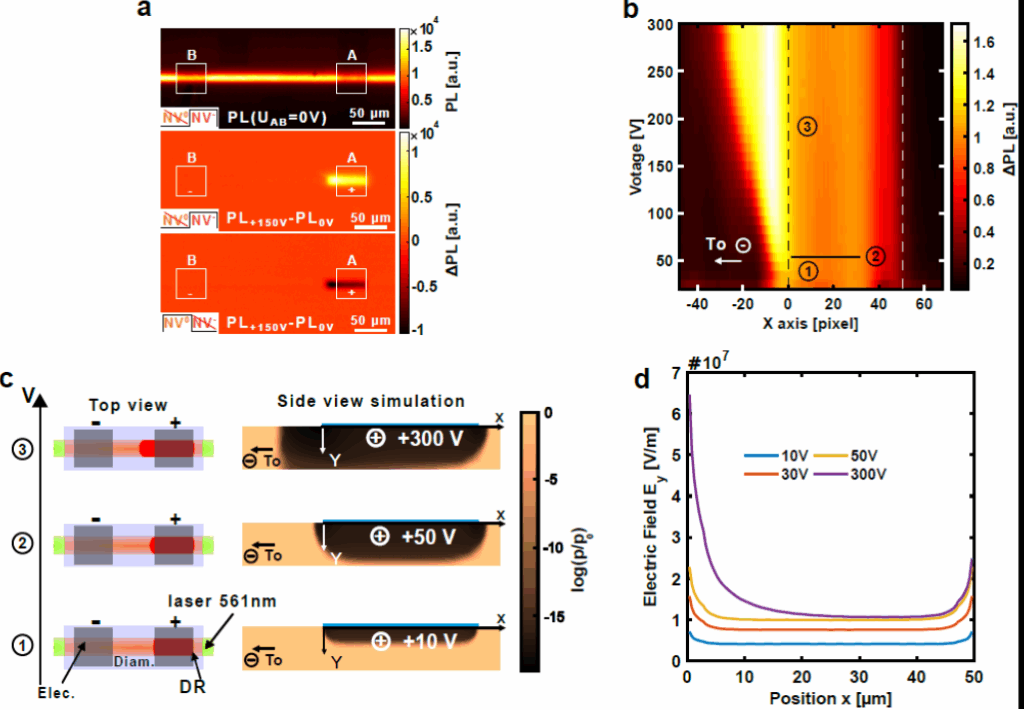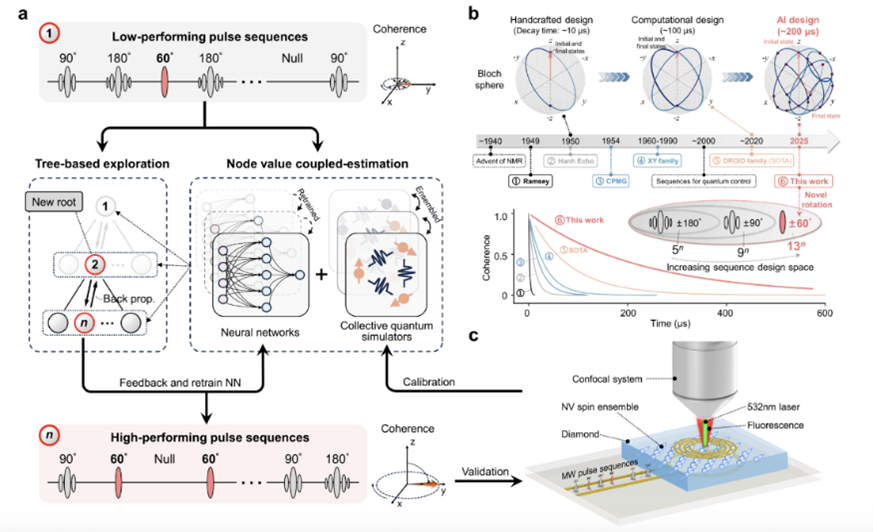Field-effect detected magnetic resonance of NV centers in diamond based on all-carbon Schottky contacts

Citation: Le, Xuan Phuc, et al. “Field-effect detected magnetic resonance of NV centers in diamond based on all-carbon Schottky contacts.” arXiv preprint arXiv:2504.11192 (2025). Authors: Le, Xuan Phuc, et al. Publication location: arXiv (identifier arXiv: 2504.11192) Date: 15 April 2025 DOI: https://doi.org/10.48550/arXiv.2504.11192 Abstract: The nitrogen vacancy (NV) center is a defect in diamond whose spin state […]
Delta-Doped Diamond via in-situ Plasma-Distance Control

Citation:Schätzle, P., et al. “Delta-Doped Diamond via in-situ Plasma-Distance Control.” arXiv preprint arXiv:2509.17521, 22 Sept. 2025. Authors: Schätzle, P., et al. Publication location:arXiv (identifier arXiv:2509.17521) Date: 22 September 2025 DOI: https://doi.org/10.48550/arXiv.2509.17521 Abstract: We present an approach for the CVD growth of diamond, where the sample is placed in a defined distance from the reactor baseplate, to […]
Learning to steer quantum many-body dynamics with tree optimization

Citation: Zhang, J. et al. (2025). Learning to steer quantum many-body dynamics with tree optimization. arXiv. https://doi.org/10.48550/arXiv.2510.07802 Authors: Zhang J., et al. Publication location: arXiv (identifier arXiv:2510.07802) Date: 9 October 2025 DOI: https://doi.org/10.48550/arXiv.2510.07802 Abstract: High-quality control over complex quantum systems is a key to achieving practical quantum technologies. However, progress is hindered by the exponential […]
Miniaturized Laser Diode Driver and Microwave Source for Transportable Quantum Sensors
Citation: Z. Li et al., “Miniaturized Laser Diode Driver and Microwave Source for Transportable Quantum Sensors,” 2024 IEEE Asia Pacific Conference on Circuits and Systems (APCCAS), Taipei, Taiwan, 2024, pp. 344-348 Authors: Zheyi Li, SinNyoung Kim; Reza Tavakoli Dinani; Yijing Zhang; Ilker Eryilmaz; Laurent Berti, Milos Nesladek Published in: 2024 IEEE Asia Pacific Conference on Circuits and Systems (APCCAS) Publisher: IEEE […]
Modelling Rabi oscillations for widefield radiofrequency imaging in nitrogen-vacancy centers in diamond
Citation: Simone Magaletti et al 2024 New J. Phys. 26 023020. Authors: Simone Magaletti, Ludovic Mayer, Jean-François Roch and Thierry Debuisschert. Publication location: New Journal of Physics, Volume 26. Year (date): 2024 D.O.I: https://doi.org/10.1088/1367-2630/ad20b0 Abstract: In this paper we study the dynamics of an ensemble of nitrogen-vacancy centers in diamond when its photoluminescence is detected […]
Efficient and all-carbon electrical readout of a NV-based quantum sensor
Citation: Appl. Phys. Lett. 122, 194001 (2023). Authors: Guillaume Villaret; Ludovic Mayer; Martin Schmidt; Simone Magaletti; Mary De Feudis; Matthew Markham; Andrew Edmonds; Jean-François Roch; Thierry Debuisschert. Publication location: Applied Physics Letters 122 Year (date): 2023 D.O.I: https://doi.org/10.1063/5.0139469 Abstract: The spin readout of an ensemble of nitrogen-vacancy (NV) centers in diamond can be realized by […]
A compact radiofrequency spectrum analyzer based on nitrogen vacancy centers in diamond
Citation: Ludovic Mayer, Simone Magaletti, Ovidiu Brinza, Alexandre Tallaire, Jocelyn Achard, Jean-François Roch, and Thierry Debuisschert “A compact radiofrequency spectrum analyzer based on nitrogen-vacancy centers in diamond”, Proc. SPIE 12430, Quantum Sensing and Nano Electronics and Photonics XIX, 124300H (15 March 2023). Authors: Ludovic Mayer, Simone Magaletti, Ovidiu Brinza, Alexandre Tallaire, Jocelyn Achard, Jean-François Roch, […]
Widefield Diamond Quantum Sensing with Neuromorphic Vision Sensors
Citation: Du, Zhiyuan & Gupta, Madhav & Xu, Feng & Zhang, Kai & Zhang, Jiahua & Zhou, Yan & Liu, Yiyao & Wang, Zhenyu & Wong, Ngai & Li, Can & Chu, Zhiqin. (2024). Widefield Diamond Quantum Sensing with Neuromorphic Vision Sensors (Adv. Sci. 2/2024). Advanced Science. 11. 10.1002/advs.202470013. Authors: Zhiyuan Du, Madhav Gupta, Feng […]
Dopant-assisted stabilization of negatively charged single nitrogen-vacancy centers in phosphorus-doped diamond at low temperatures
Citation: Geng, J., Shalomayeva, T., Gryzlova, M. et al. Dopant-assisted stabilization of negatively charged single nitrogen-vacancy centers in phosphorus-doped diamond at low temperatures. npj Quantum Inf 9, 110 (2023) Authors: Jianpei Geng, Tetyana Shalomayeva, Mariia Gryzlova, Amlan Mukherjee, Santo Santonocito, Dzhavid Dzhavadzade, Durga Bhaktavatsala, Rao Dasari, Hiromitsu Kato, Rainer Stöhr, Andrej Denisenko, Norikazu Mizuochi and Jörg Wrachtrup Publication […]
Detection of Quantum Signals Free of Classical Noise via Quantum Correlation
Citation: Shen, Yang & Wang, Ping & Cheung, Chun & Wachtrup, Joerg & Liu, Ren-Bao & Yang,Sen. (2023). Detection of quantum signals free of classical noise via quantum correlation.10.48550/arXiv.2302.13530. Authors: Yang Shen, Ping Wang, Chun Tung Cheung, Jörg Wrachtrup, Ren-Bao Liu and Sen Yang Publication location: PHYSICAL REVIEW LETTERS 130 Year (date): 2023 D.O.I: 10.1103/PhysRevLett.130.070802 Abstract: […]
